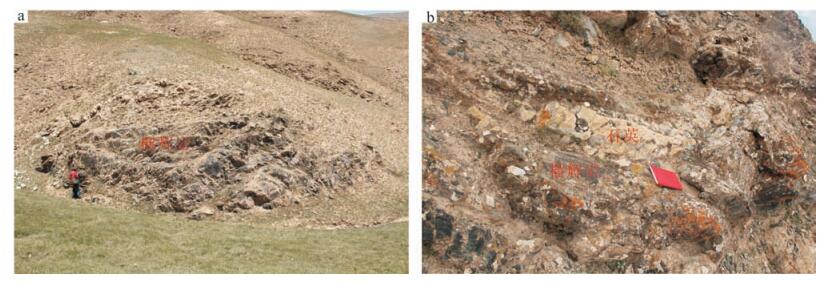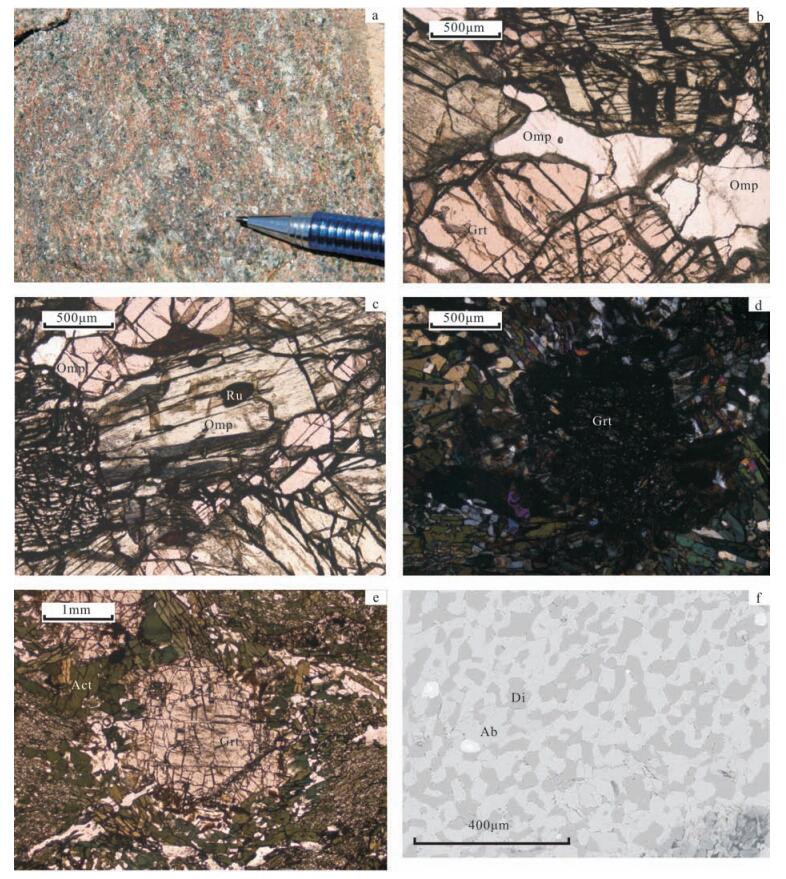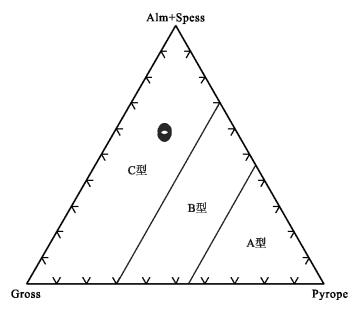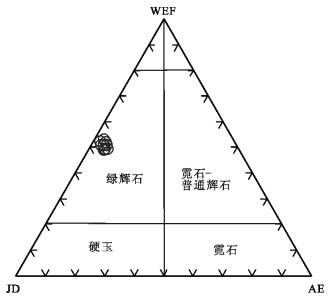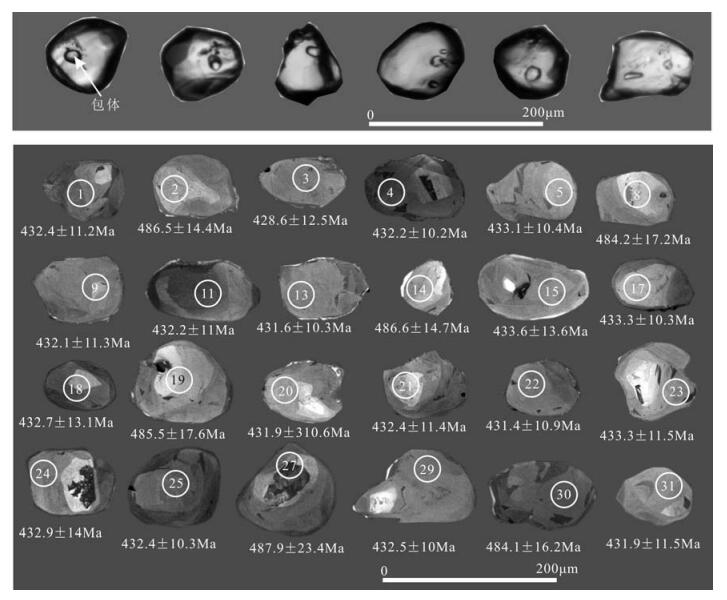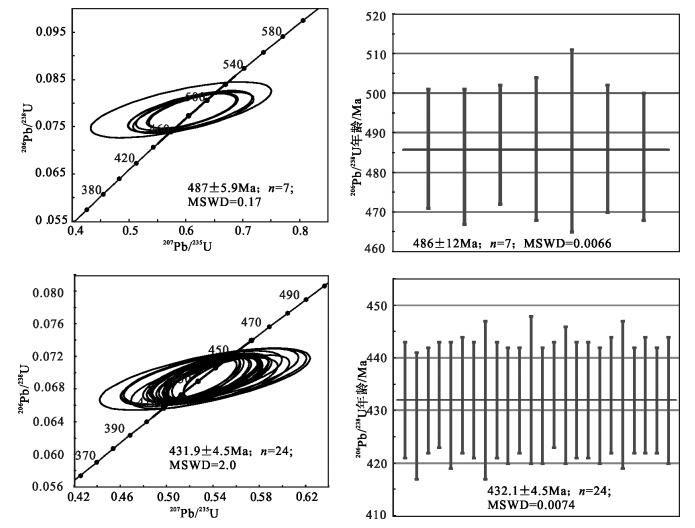The discovery of Early Paleozoic eclogite in the upper reaches of Langmuri in eastern East Kunlun Mountains and its significance
-
摘要:
在东昆仑东段郎木日上游最新识别出榴辉岩,其野外产状为透镜状、块状,与围岩呈断层接触。含榴辉岩的变质带宽1~3km,榴辉岩呈透镜体状分布于古元古界白沙河岩组变质岩及新元古代花岗片麻岩中,榴辉岩相岩石组合为榴辉岩和榴闪岩。榴辉岩相矿物组合为石榴子石+绿辉石+金红石+石英。石榴子石-单斜辉石矿物温压计估算出榴辉岩形成的温压条件为T=650~750℃,p=1.8~2.0GPa,在石榴子石Alm+Spess-Pyr-Gross三角图解中落入C型榴辉岩区。榴辉岩中锆石阴极发光图像显示,大部分具有扇形分带或杉树叶结构,少数具有弱环带结构,31颗锆石Th/U值较低(0.06~0.135),其LA-ICP-MS锆石U-Pb年龄明显分为2类,一类谐和年龄值为431.9±2.3Ma,代表了榴辉岩相峰期变质年龄;另一类谐和年龄值为487±5.9Ma,可能为原岩在俯冲过程中受构造热事件影响发生变质的结果。参考区域蛇绿岩及构造岩浆事件,确定研究区本次高压变质的峰期时代为早志留世晚期,可能发生于东昆仑俯冲消减-碰撞环境,结合邻区发现的同类型榴辉岩,恢复了一条东昆仑地区早古生代的高压变质带。
Abstract:Eclogite was recognized recently in the upper reaches of Langmuri in eastern East Kunlun Mountains. In the field, the eclogite occurs in lenticular and massive forms and exhibits fault contact with surrounding rocks. The ecologite-bearing metamorphic zone is 1~3km in width. The lenticular eclogite is distributed in metamorphic rocks of Paleoproterozoic Baishahe Formation and Neoproterozoic granite gneiss.The eclogite facies rock association is composed of eclogite and pomegranate amphibolite, and the eclogite facies mineral assemblage consists of eclogite+omphacite+rutile+quartz. According to eclogite-clinopyroxene mineral temperature and pressure gauge, the temperature and pressure conditions of eclogite rock are estimated as follows: T=650~750℃, p=1.8~2.0GPa, falling into the C-type eclogite zone in garnet Alm+Spess-Pyr-Gross triangular diagram. Zircons in the eclogite CL images show that most zircons have the fan zoning or "fir leaves" structure, with a few weak band structures. Th/U ratios of 31 zircon samples are relatively low (0.06~0.135). The LA-ICP-MS zircon U-Pb ages can be divided into two kinds: a kind of concordant age is 431.9±2.3Ma, representing the eclogite facies metamorphic peak age; the other concordant age is 487±5.9Ma. Original rock might have resulted from the deterioration that occurred under the influence of tectonic events during the subduction process. In consideration of regional ophiolite and tectonic magmatic events, the authors hold that the peak of high-pressure metamorphism in the study area occurred in late Early Silurian in the East Kunlun subduction-collision environment. Combined with the same type of eclogites found in adjacent areas, the authors restored a Palaeozoic high-pressure metamorphic belt in East Kunlun region.
-
榴辉岩作为一种高压-超高压成因的岩石,历来被广为关注。早年Eskola[1]建立了榴辉岩相,认为其主要由绿辉石和石榴子石组成,形成压力大于1GPa,Carswell等[2]将其定义为经高压变质作用,快速折返到地表形成的一种特殊岩石。20世纪90年代以来,在青藏高原及其周边陆续发现了一些榴辉岩,对其岩石性质及折返模式进行研究[3-13],为中国西部构造演化,特别是中央造山带的构造演化提供了有力的证据[11-17]。西北地区先后在阿尔金、北祁连、西南天山、柴北缘发现了加里东期榴辉岩[6, 8, 14, 18-20]。近年,祁生胜等[3]在东昆仑西段东昆北地块夏日哈木-苏海图一带,Meng等[4]在东昆仑东段东昆中断裂带附近温泉一带发现形成于加里东期的榴辉岩[3-4],这些榴辉岩与笔者在东昆仑东段浪木日上游发现的早古生代榴辉岩大地构造位置相似。该榴辉岩是否与前两者具有可对比性,能否恢复一条高压变质带?针对以上问题,本文拟展开年代学等方面的研究。
东昆仑造山带作为中央造山带重要的部分,历来是地质学家研究的热点[21-26]。近年来在东昆仑地区开展了大量不同比例尺的区域地质调查和综合研究项目[27]①②③,众多学者认为,东昆中构造混杂岩带是一条重要的构造缝合带[26-29],并获得了大量蛇绿岩、混杂岩带、侵入岩等基础性研究成果[25, 27]。根据亚东-格尔木-额济那旗等地学断面的研究结果[30-31],昆中断裂是一条规模巨大的深断裂,而岩石圈尺度三维不连续面的再活化是大陆内部成矿带的有利储矿空间[32]。因此,东昆仑造山带内部,尤其是昆中断裂带附近具有极大的找矿潜力。再者,昆仑山-柴达木作为造山带内部相对稳定的地块,推测地表下35~45km麻粒岩相岩石构成的加厚地壳下部有基性榴辉岩相岩石组成的上地幔分布[33-34],而具有高压成因的榴辉岩已出露到东昆北构造带中,是上地幔物质在地表的显示,为探讨中国西部岩石圈构造演化历史和寻找与超高压作用有关的矿产提供了宝贵的资料。
2013年起,笔者等在东昆仑开展了中国地质调查局青海省都兰县1:5万沟里乡-热水乡地区卡鲁幅区域地质调查项目,在东昆仑东段昆中断裂以北的郎木日上游昆北变质基底中发现大量新鲜榴辉岩和已发生退变质的榴闪岩,经过系统的野外调研,对榴辉岩的产状、类型及分布特征进行了详细研究,确定东昆仑造山带东段昆北构造带内部存在未发生退变质的榴辉岩,沿浪木日上游近300°走向断续延伸长达18km,为获得榴辉岩变质峰值时代及原岩年龄信息,对其进行LA-ICP-MS锆石U-Pb测年,结合区域地质背景,推测其形成可能与东昆仑造山带加里东期板块俯冲碰撞有关,并在研究区及东昆仑东段形成了大规模的构造岩浆事件[35-36]。这一成果对深入探索东昆仑造山带构造演化具有重要意义。
1. 区域地质背景
中央造山系横亘于中国大陆中部,是由中国南、北两大陆块拼合形成的巨型构造带[37-40],研究区位于中央造山系西部东昆仑造山带的东段,同样也是东昆仑造山带、秦岭造山带、柴达木地块、巴颜喀拉造山带的构造交接区域,是研究秦祁昆造山系构造交接关系和构造演化过程的重点区域。东昆仑造山带以东昆中断裂带为界,可划分为东昆北构造带、东昆南构造带,近年来将东昆北构造带以昆北断裂为界分为祁漫塔格、昆北2个构造单元,从而将东昆仑分为祁漫塔格地块、昆北构造带、昆南构造带3个构造单元[21-22, 27, 41],不同构造单元的名称不同,但划分方案和边界基本类似,其中昆北构造带实际为一基底隆起-花岗岩带,变质基底集中分布[37]。东昆仑造山带演化不是一个简单的俯冲碰撞增生过程,其具多旋回复杂演化历史,经历过多旋回的洋陆转化,碰撞后的陆内演化也很复杂[26-27, 41]。其中昆中断裂以北的昆北构造带以古元古界白沙河岩组为结晶基底,被称为硬基底或刚性基底[41],带内不同期次的花岗岩极为发育,近年来,区域地质调查表明,主体为奥陶纪-泥盆纪花岗岩和晚二叠世-晚三叠世花岗岩,2个不同旋回的花岗岩分布面积相近[3]。
研究区(图 1)构造划分隶属于东昆北构造带[23],出露地层复杂,发育多期次韧性剪切断裂及脆性断裂,岩浆活动极为发育。出露地层有古元古界白沙河岩组、中元古界小庙岩组中深变质基底岩系、下古生界纳赤台群、泥盆系契盖苏组、三叠系鄂拉山组等。其中,古元古界白沙河岩组变质程度以角闪岩相为主,局部出现麻粒岩相变质,岩石类型以角闪斜长片麻岩、黑云斜长片麻岩、斜长角闪岩、黑云石英片岩、二云石英片岩、大理岩等为主,夹含蓝晶石榴二云石英片岩、蓝晶石榴黑云石英片岩,局部有榴辉岩、榴闪岩、超基性岩等构造透镜体,岩石中面理置换强烈,尖棱褶皱、无根勾状褶皱等塑性流变普遍发育,S0被置换为S1-Sn。晋宁期、加里东期、印支期不同规模、不同类型的构造-岩浆活动分布广泛。调查发现,基底岩系面理产状多为高角度北倾,韧性构造变形较发育,糜棱岩、糜棱岩化岩石亦有发育,其糜棱面理产状与区域面理产状近于一致,糜棱岩化岩石中见有拉伸线理、σ型旋转碎斑系、SC组构等指向构造,多指示具左旋斜冲特征,局部有少量右旋逆冲特征。
2. 榴辉岩地质特征
新发现的榴辉岩大地构造位置位于东昆仑造山带东段东昆北构造带内,地理位置位于青海省都兰县热水乡浪木日上游-尕之麻一带,呈不同大小的构造块体散布于古元古界白沙河岩组及新元古代花岗质片麻岩中,近东西向断续出露长约18km,宽1~3km,构成一条高压变质带(图 2)。带内榴辉岩绝大多数透镜体呈串珠状出现,个别呈独立的透镜体出现(图 3-a),与围岩呈断层接触,长轴走向约300°,与高压带走向近于一致,平面上大小1×0.5m2~50× 14m2不等。围岩为元古宙不同地质体,包括古元古界白沙河岩组中深副变质岩与新元古代花岗片麻岩,副变质岩主要为黑云石英片岩、黑云斜长片麻岩、大理岩等。在与大理岩接触时,二者接触界线模糊,局部互为透镜体,高压带内围岩多发育糜棱岩化现象。部分榴辉岩透镜体内发育碎裂岩化,石英脉穿插发育(图 3-b),将榴辉岩切割成碎块,石英脉与榴辉岩接触界线截然,宽度5~20cm不等,在榴辉岩与围岩接触部位,也可见石英细脉。
3. 榴辉岩岩石学与矿物学特征
3.1 榴辉岩岩石学特征
研究区内发现的榴辉岩大部分较新鲜,蚀变较弱,具有典型的石榴子石+绿辉石+石英+金红石岩石组合,部分榴辉岩发生部分退变质,使石榴子石形成肉眼可见的宽0.5~1.5mm不等的“白眼圈”结构,部分退变质较彻底,岩性为榴闪岩。
榴辉岩:呈灰绿色,粒状变晶结构,块状、平行定向构造(图版Ⅰ-a),岩石由绿辉石(40%~41%)、石榴子石(36%~37%)、石英(6%)、斜长石(4%)、角闪石(4%)、金红石(5%)、不透明矿物(3%)组成。绿辉石呈粒状-短柱状变晶,边界平直,节理清晰,粒径0.7~1.8mm,与石榴子石呈粒状镶嵌平衡结构(图版Ⅰ-b),绿辉石中含有金红石、石榴子石等包裹体(图版Ⅰ-c)。石榴子石呈不规则多边形粒状变晶,未见环带结构,粒径0.35~2mm,晶体中亦可见金红石、绿辉石、不透明矿物、石英等包裹体,部分石榴子石多发生次生变质,形成变余石榴子石(图版Ⅰ-d),边部常见阳起石(图版Ⅰ-e)。石英呈他形粒状变晶,具不规则裂纹和波状消光,与其他矿物呈镶嵌结构。各矿物均呈变晶致密状。
榴闪岩:呈深灰绿色,粒状变晶结构,平行定向-块状构造,矿物变晶较细,由石榴子石(12%~13%)、石榴子石假象(由斜长石、阳起石和普通角闪石组成的集合体)(16%~17%)、角闪石(49~51%)、绿辉石(3%~10%)、透辉石(5%~6%)、斜长石(大部分为钠长石,含量约占岩石的9%~10%)、金属矿物(2%)、金红石(1%~2%)组成。石榴子石呈混圆状,部分石榴子石发生退变质,周围可见由阳起石等组成的“白眼圈”结构;绿辉石呈淡绿色,颗粒大小0.2~1mm,绝大部分发生退变质,呈残留状分布在角闪石集合体中,通过电子探针能谱散射图(图版Ⅰ-f)研究发现,退变质后的绿辉石形成透辉石+钠长石组合,二者紧密共生,与薄片鉴定结果一致;角闪石为次生半自形,粒径大小0.5~1.5mm,呈不规则状;金红石多以包裹体形式存在于石榴子石、绿辉石及两者退变质矿物中。
3.2 榴辉岩矿物学特征
样品在长安大学西部矿产资源与地质工程教育部重点实验室采用JXI8100型电子探针完成,电压15kV,电子束流1×10-8,电子束半径1μm。
据矿物学研究确定,榴辉岩的变质矿物组合为石榴子石+绿辉石+金红石+石英;榴闪岩的退变质矿物组合为角闪石+阳起石+斜长石+透辉石。早期石榴子石多数被显微指纹状绿色阳起石和斜长石集合体组成的后合成冠状体或集合体取代,故榴辉岩至少经历了榴辉岩相变质与退变质2期变质作用过程。早期榴辉岩相变质,特征变质矿物组合为石榴子石+绿辉石+金红石+石英,形成榴辉岩;后期经历不同程度的角闪岩相退变,形成发育普通角闪石+斜长石+透辉石组合的榴闪岩,石榴子石多具后合成晶环带,甚至呈假象分布,绿辉石大部分发生较完全的退变。
根据电子探针测试的矿物成分(表 1)计算,榴辉岩及榴闪岩中的12颗石榴子石成分为Alm57-60Spess0.23-0.30Gross24-25Pyr16-18,其中镁铝榴石(Pyrope)含量小于35mol%,在石榴子石Alm + Spess-Pyr-Gross三角图解[42]中落入C型榴辉岩区(图 4)。榴辉岩中9个绿辉石的Na2O含量为5.43%~6.03%,经计算,其中硬玉分子含量为43.9mol%~45.9mol%,在榴辉岩中绿辉石成分图解[43](图 5)中位于绿辉石区,表明属较典型的绿辉石。利用石榴子石-单斜辉石温度计[44-46]和绿辉石中硬玉Jd组分温度计[47]联合估算(T,p),发现当压力在1.8~2.0GPa时,温度范围一致,为650~750℃,故浪木日上游榴辉岩形成温压条件为p=1.8~2.0GPa,T=650~750℃,为高压中温榴辉岩[2]。由于样品中未发现多硅白云母及蓝晶石,通过绿辉石中硬玉组分-石榴子石测出的峰期压力应只是一个最小值[4],因此得出的压力值应该高于1.8~2.0GPa。
表 1 榴辉岩中绿辉石、石榴子石的成分Table 1. Chemistry of omphacite and garnet in eclogites序号 1.1 1.2 1.3 1.4 1.5 1.6 1.7 1.8 1.9 2.0 2.1 2.2 2.3 2.4 2.5 2.6 2.7 2.8 2.9 3.0 3.1 矿物 石榴子石 绿辉石 SiO2 55.63 55.78 56.72 55.92 56.09 56.62 56.59 56.53 56.32 37.63 38.64 38.43 38.55 38.68 38.20 38.44 38.65 38.47 38.45 38.39 38.01 T1O2 0.163 0.209 0.145 0.162 0.048 0.178 0.155 0.194 0.190 0.030 0.094 0.034 0.095 0.108 0.070 0.065 0.131 0.105 0.088 0.101 0.076 MnO 0 0.027 0.061 0.050 0.017 0.056 0.023 0.031 0.002 0.572 0.563 0.594 0.549 0.618 0.626 0.497 0.621 0.520 0.522 0.605 0.473 Al2O3 10.29 10.27 10.93 10.35 10.51 10.89 10.83 10.75 10.85 21.14 21.38 21.43 21.55 21.19 21.58 21.52 21.67 21.12 21.21 21.55 20.96 FeO 6.185 6.221 6.177 6.268 6.096 6.453 5.928 6.123 5.922 26.89 27.67 27.63 27.15 27.67 27.85 27.08 27.12 26.78 26.78 27.81 27.14 CaO 12.54 12.60 12.35 12.55 12.63 12.90 12.25 12.62 12.66 8.683 8.536 8.512 8.410 8.644 8.495 8.513 8.532 8.628 8.770 8.347 8.477 MgO 7.548 7.676 7.036 7.347 7.208 7.199 7.386 7.305 7.234 4.224 4.388 4.260 4.315 4.506 4.197 4.475 4.507 4.431 4.496 4.171 4.322 K2O 0.008 0 0 0.014 0 0 0.022 0.023 0.019 0.004 0 0.015 0.012 0 0 0 0 0.005 0.004 0 0 Na2O 5.553 5.433 6.011 5.726 5.656 5.969 5.848 5.732 6.032 0.023 0.032 0.034 0.019 0.025 0.023 0.051 0.040 0.043 0.040 0 0.044 Cr2O3 0.012 0.032 0.012 0.022 0 0 0 0 0.037 0.055 0.016 0.023 0.009 0.034 0 0 0 0 0 0.014 0.044 SrO 0.202 0.124 0.247 0.181 0.166 0.178 0.165 0.180 0.151 0.092 0.109 0.094 0.080 0.069 0.121 0.110 0.059 0.150 0.081 0.176 0.035 Total 98.14 98.36 99.69 98.59 98.42 100.4 99.20 99.48 99.42 99.34 101.4 101.1 100.7 101.6 101.2 100.7 101.3 100.3 100.4 101.2 99.59 O 6.000 6.000 6.000 6.000 6.000 6.000 6.000 6.000 6.000 12.00 12.00 12.00 12.00 12.00 12.00 12.00 12.00 12.00 12.00 12.00 12.00 Si 2.048 2.050 2.054 2.049 2.059 2.036 2.057 2.053 2.041 2.972 2.991 2.986 3.002 2.990 2.968 2.990 2.989 3.008 2.999 2.985 2.995 Ti 0.005 0.006 0.004 0.004 0.001 0.005 0.004 0.005 0.005 0.002 0.005 0.002 0.006 0.006 0.004 0.004 0.008 0.006 0.005 0.006 0.005 Mn 0 0.001 0.002 0.002 0.001 0.002 0.001 0.001 0 0.038 0.037 0.039 0.036 0.040 0.041 0.033 0.041 0.034 0.034 0.040 0.032 Al 0.446 0.445 0.467 0.447 0.455 0.462 0.464 0.460 0.463 1.967 1.951 1.963 1.977 1.931 1.976 1.972 1.974 1.947 1.950 1.974 1.946 Fe3+ 0.037 0.030 0.055 0.049 0.063 0.016 0.055 0.040 0.031 0.085 0.061 0.066 0.011 0.079 0.084 0.049 0.039 0.032 0.049 0.044 0.059 Fe2+ 0.153 0.161 0.132 0.143 0.124 0.178 0.126 0.146 0.148 1.692 1.731 1.730 1.757 1.710 1.725 1.712 1.715 1.719 1.698 1.764 1.730 Ca 0.495 0.496 0.479 0.493 0.497 0.497 0.477 0.491 0.491 0.735 0.708 0.709 0.702 0.716 0.707 0.709 0.707 0.723 0.733 0.695 0.716 Mg 0.414 0.421 0.380 0.401 0.394 0.386 0.400 0.395 0.391 0.497 0.506 0.493 0.501 0.519 0.486 0.519 0.520 0.517 0.523 0.483 0.508 K 0 0 0 0.001 0 0 0.001 0.001 0.001 0 0 0.001 0.001 0 0 0 0 0 0 0 0 Na 0.396 0.387 0.422 0.407 0.403 0.416 0.412 0.404 0.424 0.004 0.005 0.005 0.003 0.004 0.003 0.008 0.006 0.007 0.006 0 0.007 Cr 0 0.001 0 0.001 0 0 0 0 0.001 0.003 0.001 0.001 0.001 0.002 0 0 0 0 0 0.001 0.003 Sr 0.004 0.003 0.005 0.004 0.004 0.004 0.003 0.004 0.003 0.004 0.005 0.004 0.004 0.003 0.005 0.005 0.003 0.007 0.004 0.008 0.002 cations 4.000 4.000 4.000 4.000 4.000 4.000 4.000 4.000 4.000 8.000 8.000 8.000 8.000 8.000 8.000 8.000 8.000 8.000 8.000 8.000 8.000 ![]() 图 4 榴辉岩中石榴子石成分图解[42]Alm-铁铝榴石;Spess-锰铝榴石;Gross-钙铝榴石;Pyrope-镁铝榴石Figure 4. Composition of garnets in eclogites
图 4 榴辉岩中石榴子石成分图解[42]Alm-铁铝榴石;Spess-锰铝榴石;Gross-钙铝榴石;Pyrope-镁铝榴石Figure 4. Composition of garnets in eclogites4. 榴辉岩锆石U-Pb同位素年龄
为了获得浪木日上游榴辉岩变质峰值年龄及原岩时代信息,采用LA-ICP-MS方法对榴辉岩锆石进行了U-Pb同位素测试。样品采自浪木日上游尕之麻一带,地理坐标为北纬35°43′3.15″、东经98° 42′23.85″,样品编号为D1817/1。将采得的新鲜榴辉岩样品送至廊坊诚信地质科技有限公司选矿室挑选锆石,从约15kg新鲜岩石样品中分离得到。分离出来的锆石在双目镜下挑出透明度好、无包体、无裂隙的颗粒,用无色透明的环氧树脂固定,待环氧树脂充分固化后,对其表面进行抛光,至锆石颗粒1/2出露;然后在长安大学西部矿产资源与地质工程教育部重点实验室扫描电镜加载阴极发光仪上完成阴极发光(CL)照相,在西北大学大陆动力学国家重点实验室完成LA-ICP-MS同位素分析。LA-ICP-MS分析在Hewlett Packard公司最新一代带有Shield Torch的Agilient 7500a ICP-MS和德国Lambda Physik公司的ComPex102 Excimer激光器(工作物质ArF,波长193nm)及MicroLas公司的Ge-oLas 200M光学系统联机上进行,锆石U-Pb同位素测定的激光束斑直径为30μm,激光剥蚀样品的深度为20~40μm。实验中采用氦作为剥蚀物质的载气,用美国国家标准技术研究院研制的人工合成硅酸盐玻璃标准参考物质NIST SRM610进行仪器最佳化,锆石年龄采用国际标准锆石91500作为外标标准物质,元素含量采用NIST SRM610作为外标,29Si作为内标元素进行校正。样品的同位素比值和元素含量数据处理采用Glitter(ver4.0, Macquarie University)程序,并采用Anderson[48]软件对测试数据进行普通铅校正,年龄计算及谐和图绘制采用Isoplot(2.49版)[49]软件完成。详细的实验原理、流程及仪器见参考文献[50-52]。
锆石的反射光照片可见,榴辉岩样品中的锆石多呈不规则-浑圆状晶体,显微镜下呈无色-淡黄色,颗粒大小在80~150μm之间。锆石透射光照片显示(图 6),绝大多数锆石见浑圆状的包裹体,大小为10~20μm,成分未知,部分锆石裂纹发育。阴极发光(CL)图像(图 6)显示,部分锆石保留有残核,锆石颗粒间明暗强度有变化,个别锆石边部见较亮的次生边,推测为后期热蚀变所致。为得到精确年龄信息,测试点均避开包裹体及裂纹。锆石内部环带不明显或有弱的环带,大多具有扇形分带或“杉树叶”结构,为典型的变质锆石特征[53-54]。
本次共测试31个点,根据年龄可分为2组,第一组7个点,分别为2、8、14、19、27、28、30号点,位置位于锆石核部或次核部,CL图像显示其可能为变质残核,U含量为120.27×10-6~278.78×10-6,平均为175.41×10-6,Th为13.25×10-6~25.97×10-6,平均为18.04×10-6,Th/U值在0.09~0.12之间,平均为0.105(表 2),为典型的变质成因锆石[53-54]。206Pb/238U与207Pb/235U谐和年龄(图 7)为487±5.9Ma(MSWD=0.17),206Pb/238U直方年龄为486±12Ma(MSWD=0.0066),二者在误差范围内一致,可能为原岩在板块俯冲过程中受构造热事件影响发生变质的记录;第二组共24个点,U含量为129.59 × 10-6~582.19×10-6,平均为287.07×10-6,Th为14.42×10-6~42.64×10-6,平均为28.2×10-6,Th/U值在0.06~0.14之间,平均为0.1007(表 2),206Pb/238U与207Pb/235U谐和年龄为431.9±2.3Ma(MSWD=2),206Pb/238U直方年龄为432.1±4.5Ma(MSWD=0.0074),二者在误差范围内近于一致。据研究,变质重结晶锆石具有较低的Th/U值,且变质重结晶作用越强,变质重结晶锆石的Th/U值越低[55],因此,那些Th/U值最低、年龄值最小的测点年龄加权平均值才能代表锆石重结晶作用发生的时间[56],故第二组年龄代表了重结晶作用最强的发生时间。榴辉岩的形成温度为650~750℃,与锆石U-Pb的封闭温度[57]基本一致,故该年龄代表榴辉岩锆石变质峰值年龄,变质峰值年龄为431.9±2.3Ma,时代为早志留世晚期。
表 2 榴辉岩(D1817/1)LA-ICP-MS锆石U-Th-Pb分析数据Table 2. LA-ICP-MS U-Th-Pb data of zircons from eclogite (D1817/1)分析 206Pb 232Th 238U Th/U 同位素比值 年龄/Ma 点位 含量/10-6 207Pb/206Pb 1σ 207Pb/235U 1σ 206Pb/238U 1σ 208Pb/232Th 1σ 207Pb/206Pb 1σ 207Pb/235U 1σ 206Pb/238U 1σ 01 96.6 41.5 324.6 0.128 0.0558 0.0032 0.5336 0.0303 0.0694 0.0019 0.0218 0.0014 443 122 434 20 432 11 02 54.1 16.6 160.9 0.103 0.0567 0.0048 0.6128 0.0516 0.0784 0.0025 0.0738 0.0051 479 179 485 33 487 15 03 92.0 22.5 312.1 0.072 0.0562 0.0045 0.5326 0.0419 0.0688 0.0021 0.0213 0.0026 459 168 434 28 429 13 04 100.4 27.2 337.4 0.081 0.0559 0.0020 0.5342 0.0196 0.0693 0.0017 0.0226 0.0011 446 77 435 13 432 10 05 88.8 39.6 297.8 0.133 0.0557 0.0023 0.5334 0.0221 0.0695 0.0017 0.0226 0.0010 439 88 434 15 433 10 06 78.5 27.7 264.2 0.105 0.0556 0.0035 0.5302 0.0334 0.0692 0.0019 0.0212 0.0018 434 135 432 22 431 12 07 73.7 28.1 247.1 0.114 0.0555 0.0033 0.5321 0.0312 0.0695 0.0019 0.0257 0.0017 433 126 433 21 433 11 08 40.3 13.3 120.3 0.110 0.0570 0.0066 0.6127 0.0701 0.0780 0.0029 0.0168 0.0029 489 239 485 44 484 17 09 94.3 34.2 316.6 0.108 0.0564 0.0034 0.5396 0.0321 0.0693 0.0019 0.0175 0.0014 469 128 438 21 432 11 10 43.6 15.2 146.5 0.104 0.0558 0.0064 0.5330 0.0600 0.0692 0.0025 0.0298 0.0038 445 237 434 40 432 15 11 97.5 25.9 327.3 0.079 0.0562 0.0030 0.5369 0.0288 0.0693 0.0018 0.0200 0.0016 458 115 436 19 432 11 12 95.3 29.8 321.0 0.093 0.0568 0.0029 0.5407 0.0280 0.0691 0.0018 0.0253 0.0016 481 111 439 18 431 11 13 81.7 26.6 274.4 0.097 0.0553 0.0022 0.5284 0.0211 0.0693 0.0017 0.0243 0.0011 426 85 431 14 432 10 14 62.8 20.0 186.3 0.108 0.0564 0.0049 0.6102 0.0523 0.0784 0.0025 0.0291 0.0030 469 183 484 33 487 15 15 78.7 22.7 262.8 0.086 0.0561 0.0053 0.5385 0.0499 0.0696 0.0023 0.0235 0.0030 457 196 437 33 434 14 16 41.8 14.4 140.2 0.103 0.0556 0.0033 0.5305 0.0315 0.0692 0.0019 0.0245 0.0018 436 128 432 21 431 11 17 76.1 22.9 254.4 0.090 0.0553 0.0022 0.5303 0.0217 0.0695 0.0017 0.0236 0.0012 425 87 432 14 433 10 18 75.6 32.5 253.1 0.128 0.0554 0.0049 0.5303 0.0458 0.0694 0.0022 0.0264 0.0024 428 185 432 30 433 13 19 40.5 14.9 120.3 0.124 0.0562 0.0068 0.6066 0.0722 0.0782 0.0029 0.0284 0.0038 461 249 481 46 486 18 20 75.2 20.8 252.0 0.082 0.0565 0.0027 0.5402 0.0256 0.0693 0.0018 0.0257 0.0016 473 101 439 17 432 11 21 38.7 14.5 129.6 0.112 0.0562 0.0035 0.5379 0.0333 0.0694 0.0019 0.0258 0.0018 460 133 437 22 432 11 22 94.0 42.6 315.2 0.135 0.0555 0.0030 0.5296 0.0287 0.0692 0.0018 0.0220 0.0013 432 117 432 19 431 11 23 92.3 33.4 308.0 0.108 0.0561 0.0035 0.5374 0.0336 0.0695 0.0019 0.0257 0.0018 455 134 437 22 433 11 24 45.7 14.5 152.7 0.095 0.0565 0.0056 0.5405 0.0530 0.0695 0.0023 0.0143 0.0023 469 208 439 35 433 14 25 139.0 28.0 464.9 0.060 0.0573 0.0023 0.5485 0.0223 0.0694 0.0017 0.0262 0.0015 504 86 444 15 432 10 26 100.6 38.2 336.0 0.114 0.0568 0.0032 0.5441 0.0307 0.0694 0.0018 0.0205 0.0014 485 121 441 20 433 11 27 65.11 19.2 192.0 0.100 0.0545 0.0099 0.5908 0.1050 0.0786 0.0039 0.0187 0.0052 392 363 471 67 488 23 28 94.12 26.0 278.8 0.093 0.0557 0.0056 0.6007 0.0589 0.0783 0.0026 0.0233 0.0032 439 208 478 37 486 16 29 174.3 42.2 582.2 0.072 0.0567 0.0019 0.5427 0.0187 0.0694 0.0017 0.0253 0.0011 481 72 440 12 433 10 30 56.99 16.3 169.3 0.096 0.0552 0.0059 0.5931 0.0626 0.0780 0.0027 0.0232 0.0033 419 224 473 40 484 16 31 80.69 32.0 269.8 0.119 0.0579 0.0037 0.5532 0.0350 0.0693 0.0019 0.0236 0.0017 526 134 447 23 432 12 5. 榴辉岩地质意义
新元古代晚期,受控于Rodinia超大陆裂解事件下的全球统一构造和动力学机制,东昆仑、巴颜喀拉地区及西秦岭整体处于离散状态。东昆仑金水口南形成于大陆裂谷环境年龄为796±41Ma的变余辉长岩[58]是对Rodinia超大陆裂解事件的响应,表明至少从796±41Ma开始,东昆仑地区已经开始裂解。随着东昆仑地区进一步拉张裂解和成洋,布青山地区年龄为516.4±6.3Ma的得力利斯坦MOR型蛇绿岩[59]、阿尼玛卿玛积雪山地区年龄为535±10Ma的早古生代洋脊型辉长岩[60]等为代表的原特提斯洋洋壳开始形成。
在洋壳扩张的同时,布青山-阿尼玛卿原特提斯洋的北缘在早寒武世时已经开始向北俯冲消减,在东昆中地区出现拉张的局限小洋盆。研究区内的长石山蛇绿岩中辉长岩的锆石U-Pb年龄为537.2±3.5Ma,形成的构造环境为弧后盆地[61],表明该时期,原特提斯洋向北俯冲,导致东昆中长石山一带已出现弧后拉张的小洋盆。伴随俯冲作用,东昆中地区持续拉张形成了清水泉蛇绿岩(522.3±4.1Ma,518±3Ma)[62-63]、塔妥蛇绿岩(521.9±3.2Ma)③、曲什昂蛇绿岩(504.5±5.5Ma)③等洋壳物质,代表了弧后洋盆的持续扩张。分布于东昆仑东段的下古生界纳赤台岩群为一套变沉积-火山岩,其变基性火山岩的锆石U-Pb年龄为474.0±7.9Ma,形成环境为弧后盆地,同样也是东昆仑地区原特提斯洋洋壳向北俯冲导致弧后扩张的证据[64]。
晚奥陶世-早志留世,原特提斯主洋盆及产出清水泉蛇绿岩、长石山蛇绿岩的东昆中地区的弧后盆地以俯冲消减为主。布青山白日切特地区发育一套中酸性岩浆岩,其中岛弧型花岗闪长岩锆石U-Pb年龄为441±6Ma,岛弧型流纹斑岩的锆石UPb年龄为438±3Ma[65],布青山地区亿可哈拉尔花岗闪长岩具有典型埃达克岩地球化学特征,锆石UPb年龄为436.9±5.7Ma[66],香日德南部已发生变形变质的岛弧型闪长岩的锆石U-Pb年龄为446.5±9.1Ma[67],清水泉地区辉绿岩脉的锆石U-Pb年龄为436.4±1.2Ma[68],研究区长石山混杂岩带北部的克和特地区获得具埃达克岩性质的岛弧型花岗闪长岩锆石U-Pb年龄为454.3±3.6Ma(项目未刊资料),这些均为洋壳俯冲阶段的构造岩浆响应。
中-晚志留世以后,东昆仑地区进入碰撞造山和陆内演化阶段。东昆中断裂带高角度逆冲变形年龄为426~408Ma[69],东昆仑东段跃进山岩体中花岗闪长岩和辉长岩的锆石U-Pb年龄分别为407±3Ma和406±3Ma[70],东昆仑东段和勒冈那仁A型碱长花岗岩的锆石U-Pb年龄为425±6.7Ma[71],东昆仑冰沟A型花岗岩的锆石U-Pb年龄为391±3Ma[72],长石山混杂岩带北部拉龙一带同碰撞花岗岩体的锆石U-Pb年龄为423±4.6Ma(项目未刊资料)等,都是东昆仑地区在早古生代碰撞造山的有力证据。陆露等[73]报道的昆中断裂带2个同构造花岗斑岩的锆石U-Pb年龄分别为408.5±2.3Ma和391.2±3.4Ma,是东昆仑造山带在加里东造山晚期陆内构造变形阶段的产物。泥盆系牦牛山组伸展型磨拉石组合标志着早古生代构造旋回的结束和晚古生代构造旋回的开始[66, 71, 74]。
东昆仑东段浪木日上游发现的早古生代榴辉岩,峰值变质年龄为431.9±4.5Ma,根据区域地质背景推测其产生于东昆仑俯冲消减-碰撞环境,大于1.8GPa的压力表明,这些榴辉岩形成的深度应该大于50km[75],而后沿构造薄弱带折返至东昆仑郎木日上游一带的元古代地质体中。
结合祁生胜等[3]、Meng等[4]的报道,东昆仑西段夏日哈木-苏海图一带获得的206Pb/238U年龄加权平均值为410.9±1.6Ma,榴辉岩类型为C型榴辉岩,温压条件为p≈2.0GPa,T=660~700℃;东昆仑东部温泉地区榴辉岩变质峰值206Pb/238U年龄加权平均值为428±2Ma,榴辉岩类型为C型榴辉岩,温压条件为p>1.6GPa,T=590~650℃[4];本次研究获得东昆仑东段浪木日上游一带榴辉岩206Pb/238U年龄加权平均值为432.1±4.5Ma,榴辉岩类型同样为C型榴辉岩,温压条件为p=1.8~2.0GPa,T=650~750℃,三者变质峰值年龄、岩石类型、温压条件近于一致,因此将三者沿构造线连接,恢复了一条早古生代东昆仑地区的高压变质带,为寻找与超高压作用有关的矿产和探讨中国西部岩石圈构造演化历史提供了宝贵的资料。
6. 结论
(1)在东昆仑东段昆中断裂以北的北昆仑构造带内部变质基底中发现经历高压变质作用形成的榴辉岩,该榴辉岩呈透镜状、块状产出于古元古界白沙河岩组变质岩及新元古代花岗质片麻岩中,岩石中发育典型的绿辉石+石榴子石+金红石+石英的高压变质矿物组合。
(2)部分榴辉岩经历了强烈的退变质作用形成榴闪岩,绿辉石多被透辉石+钠长石后成合晶替代,部分石榴子石蜕变为由斜长石、阳起石、普通角闪石等组成的集合体,形成石榴子石假象。
(3)浪木日上游榴辉岩为典型的变质榴辉岩,类型为C型榴辉岩,绿辉石中硬玉分子含量为43.9mol%~45.9mol%,峰期变质条件p=1.8~2.0GPa,T=650~750℃,为高压中温榴辉岩。
(4)榴辉岩中锆石发育较多包裹体,CL图像显示大部分具有扇形分带或“杉树叶”结构,少数发育弱环带结构,结合锆石成分,判断其为典型的变质锆石。按年龄区间,可明显分为2类,第一类共7颗锆石,206Pb/238U与207Pb/235U谐和年龄为487±5.9Ma,206Pb/238U直方年龄为486±12Ma,代表原岩在板块俯冲过程中受构造热事件影响发生变质的结果;第二类共24颗锆石,206Pb/238U与207Pb/235U谐和年龄为431.9±2.3Ma,206Pb/238U直方年龄为432.1±4.5Ma,代表了榴辉岩相峰期的变质时代。结合区域变质作用和构造岩浆事件,本次高压变质的峰期时代为早志留世晚期。
(5)结合区域资料及邻区发现的同类型榴辉岩,恢复了一条早古生代东昆仑地区的高压变质带。
致谢: 参加本项目野外工作的还有蔡振锋、屈小相、翟黎明、魏伟、申恒明、李政林等同志,成文过程中与青海省地质调查院祁生胜教授级高级工程师、中国地质调查局西安地质调查中心李向民研究员进行了有益的探讨,审稿专家提出了宝贵的修改意见,在此一并表示诚挚的谢意。 -
图 4 榴辉岩中石榴子石成分图解[42]
Alm-铁铝榴石;Spess-锰铝榴石;Gross-钙铝榴石;Pyrope-镁铝榴石
Figure 4. Composition of garnets in eclogites
表 1 榴辉岩中绿辉石、石榴子石的成分
Table 1 Chemistry of omphacite and garnet in eclogites
序号 1.1 1.2 1.3 1.4 1.5 1.6 1.7 1.8 1.9 2.0 2.1 2.2 2.3 2.4 2.5 2.6 2.7 2.8 2.9 3.0 3.1 矿物 石榴子石 绿辉石 SiO2 55.63 55.78 56.72 55.92 56.09 56.62 56.59 56.53 56.32 37.63 38.64 38.43 38.55 38.68 38.20 38.44 38.65 38.47 38.45 38.39 38.01 T1O2 0.163 0.209 0.145 0.162 0.048 0.178 0.155 0.194 0.190 0.030 0.094 0.034 0.095 0.108 0.070 0.065 0.131 0.105 0.088 0.101 0.076 MnO 0 0.027 0.061 0.050 0.017 0.056 0.023 0.031 0.002 0.572 0.563 0.594 0.549 0.618 0.626 0.497 0.621 0.520 0.522 0.605 0.473 Al2O3 10.29 10.27 10.93 10.35 10.51 10.89 10.83 10.75 10.85 21.14 21.38 21.43 21.55 21.19 21.58 21.52 21.67 21.12 21.21 21.55 20.96 FeO 6.185 6.221 6.177 6.268 6.096 6.453 5.928 6.123 5.922 26.89 27.67 27.63 27.15 27.67 27.85 27.08 27.12 26.78 26.78 27.81 27.14 CaO 12.54 12.60 12.35 12.55 12.63 12.90 12.25 12.62 12.66 8.683 8.536 8.512 8.410 8.644 8.495 8.513 8.532 8.628 8.770 8.347 8.477 MgO 7.548 7.676 7.036 7.347 7.208 7.199 7.386 7.305 7.234 4.224 4.388 4.260 4.315 4.506 4.197 4.475 4.507 4.431 4.496 4.171 4.322 K2O 0.008 0 0 0.014 0 0 0.022 0.023 0.019 0.004 0 0.015 0.012 0 0 0 0 0.005 0.004 0 0 Na2O 5.553 5.433 6.011 5.726 5.656 5.969 5.848 5.732 6.032 0.023 0.032 0.034 0.019 0.025 0.023 0.051 0.040 0.043 0.040 0 0.044 Cr2O3 0.012 0.032 0.012 0.022 0 0 0 0 0.037 0.055 0.016 0.023 0.009 0.034 0 0 0 0 0 0.014 0.044 SrO 0.202 0.124 0.247 0.181 0.166 0.178 0.165 0.180 0.151 0.092 0.109 0.094 0.080 0.069 0.121 0.110 0.059 0.150 0.081 0.176 0.035 Total 98.14 98.36 99.69 98.59 98.42 100.4 99.20 99.48 99.42 99.34 101.4 101.1 100.7 101.6 101.2 100.7 101.3 100.3 100.4 101.2 99.59 O 6.000 6.000 6.000 6.000 6.000 6.000 6.000 6.000 6.000 12.00 12.00 12.00 12.00 12.00 12.00 12.00 12.00 12.00 12.00 12.00 12.00 Si 2.048 2.050 2.054 2.049 2.059 2.036 2.057 2.053 2.041 2.972 2.991 2.986 3.002 2.990 2.968 2.990 2.989 3.008 2.999 2.985 2.995 Ti 0.005 0.006 0.004 0.004 0.001 0.005 0.004 0.005 0.005 0.002 0.005 0.002 0.006 0.006 0.004 0.004 0.008 0.006 0.005 0.006 0.005 Mn 0 0.001 0.002 0.002 0.001 0.002 0.001 0.001 0 0.038 0.037 0.039 0.036 0.040 0.041 0.033 0.041 0.034 0.034 0.040 0.032 Al 0.446 0.445 0.467 0.447 0.455 0.462 0.464 0.460 0.463 1.967 1.951 1.963 1.977 1.931 1.976 1.972 1.974 1.947 1.950 1.974 1.946 Fe3+ 0.037 0.030 0.055 0.049 0.063 0.016 0.055 0.040 0.031 0.085 0.061 0.066 0.011 0.079 0.084 0.049 0.039 0.032 0.049 0.044 0.059 Fe2+ 0.153 0.161 0.132 0.143 0.124 0.178 0.126 0.146 0.148 1.692 1.731 1.730 1.757 1.710 1.725 1.712 1.715 1.719 1.698 1.764 1.730 Ca 0.495 0.496 0.479 0.493 0.497 0.497 0.477 0.491 0.491 0.735 0.708 0.709 0.702 0.716 0.707 0.709 0.707 0.723 0.733 0.695 0.716 Mg 0.414 0.421 0.380 0.401 0.394 0.386 0.400 0.395 0.391 0.497 0.506 0.493 0.501 0.519 0.486 0.519 0.520 0.517 0.523 0.483 0.508 K 0 0 0 0.001 0 0 0.001 0.001 0.001 0 0 0.001 0.001 0 0 0 0 0 0 0 0 Na 0.396 0.387 0.422 0.407 0.403 0.416 0.412 0.404 0.424 0.004 0.005 0.005 0.003 0.004 0.003 0.008 0.006 0.007 0.006 0 0.007 Cr 0 0.001 0 0.001 0 0 0 0 0.001 0.003 0.001 0.001 0.001 0.002 0 0 0 0 0 0.001 0.003 Sr 0.004 0.003 0.005 0.004 0.004 0.004 0.003 0.004 0.003 0.004 0.005 0.004 0.004 0.003 0.005 0.005 0.003 0.007 0.004 0.008 0.002 cations 4.000 4.000 4.000 4.000 4.000 4.000 4.000 4.000 4.000 8.000 8.000 8.000 8.000 8.000 8.000 8.000 8.000 8.000 8.000 8.000 8.000 表 2 榴辉岩(D1817/1)LA-ICP-MS锆石U-Th-Pb分析数据
Table 2 LA-ICP-MS U-Th-Pb data of zircons from eclogite (D1817/1)
分析 206Pb 232Th 238U Th/U 同位素比值 年龄/Ma 点位 含量/10-6 207Pb/206Pb 1σ 207Pb/235U 1σ 206Pb/238U 1σ 208Pb/232Th 1σ 207Pb/206Pb 1σ 207Pb/235U 1σ 206Pb/238U 1σ 01 96.6 41.5 324.6 0.128 0.0558 0.0032 0.5336 0.0303 0.0694 0.0019 0.0218 0.0014 443 122 434 20 432 11 02 54.1 16.6 160.9 0.103 0.0567 0.0048 0.6128 0.0516 0.0784 0.0025 0.0738 0.0051 479 179 485 33 487 15 03 92.0 22.5 312.1 0.072 0.0562 0.0045 0.5326 0.0419 0.0688 0.0021 0.0213 0.0026 459 168 434 28 429 13 04 100.4 27.2 337.4 0.081 0.0559 0.0020 0.5342 0.0196 0.0693 0.0017 0.0226 0.0011 446 77 435 13 432 10 05 88.8 39.6 297.8 0.133 0.0557 0.0023 0.5334 0.0221 0.0695 0.0017 0.0226 0.0010 439 88 434 15 433 10 06 78.5 27.7 264.2 0.105 0.0556 0.0035 0.5302 0.0334 0.0692 0.0019 0.0212 0.0018 434 135 432 22 431 12 07 73.7 28.1 247.1 0.114 0.0555 0.0033 0.5321 0.0312 0.0695 0.0019 0.0257 0.0017 433 126 433 21 433 11 08 40.3 13.3 120.3 0.110 0.0570 0.0066 0.6127 0.0701 0.0780 0.0029 0.0168 0.0029 489 239 485 44 484 17 09 94.3 34.2 316.6 0.108 0.0564 0.0034 0.5396 0.0321 0.0693 0.0019 0.0175 0.0014 469 128 438 21 432 11 10 43.6 15.2 146.5 0.104 0.0558 0.0064 0.5330 0.0600 0.0692 0.0025 0.0298 0.0038 445 237 434 40 432 15 11 97.5 25.9 327.3 0.079 0.0562 0.0030 0.5369 0.0288 0.0693 0.0018 0.0200 0.0016 458 115 436 19 432 11 12 95.3 29.8 321.0 0.093 0.0568 0.0029 0.5407 0.0280 0.0691 0.0018 0.0253 0.0016 481 111 439 18 431 11 13 81.7 26.6 274.4 0.097 0.0553 0.0022 0.5284 0.0211 0.0693 0.0017 0.0243 0.0011 426 85 431 14 432 10 14 62.8 20.0 186.3 0.108 0.0564 0.0049 0.6102 0.0523 0.0784 0.0025 0.0291 0.0030 469 183 484 33 487 15 15 78.7 22.7 262.8 0.086 0.0561 0.0053 0.5385 0.0499 0.0696 0.0023 0.0235 0.0030 457 196 437 33 434 14 16 41.8 14.4 140.2 0.103 0.0556 0.0033 0.5305 0.0315 0.0692 0.0019 0.0245 0.0018 436 128 432 21 431 11 17 76.1 22.9 254.4 0.090 0.0553 0.0022 0.5303 0.0217 0.0695 0.0017 0.0236 0.0012 425 87 432 14 433 10 18 75.6 32.5 253.1 0.128 0.0554 0.0049 0.5303 0.0458 0.0694 0.0022 0.0264 0.0024 428 185 432 30 433 13 19 40.5 14.9 120.3 0.124 0.0562 0.0068 0.6066 0.0722 0.0782 0.0029 0.0284 0.0038 461 249 481 46 486 18 20 75.2 20.8 252.0 0.082 0.0565 0.0027 0.5402 0.0256 0.0693 0.0018 0.0257 0.0016 473 101 439 17 432 11 21 38.7 14.5 129.6 0.112 0.0562 0.0035 0.5379 0.0333 0.0694 0.0019 0.0258 0.0018 460 133 437 22 432 11 22 94.0 42.6 315.2 0.135 0.0555 0.0030 0.5296 0.0287 0.0692 0.0018 0.0220 0.0013 432 117 432 19 431 11 23 92.3 33.4 308.0 0.108 0.0561 0.0035 0.5374 0.0336 0.0695 0.0019 0.0257 0.0018 455 134 437 22 433 11 24 45.7 14.5 152.7 0.095 0.0565 0.0056 0.5405 0.0530 0.0695 0.0023 0.0143 0.0023 469 208 439 35 433 14 25 139.0 28.0 464.9 0.060 0.0573 0.0023 0.5485 0.0223 0.0694 0.0017 0.0262 0.0015 504 86 444 15 432 10 26 100.6 38.2 336.0 0.114 0.0568 0.0032 0.5441 0.0307 0.0694 0.0018 0.0205 0.0014 485 121 441 20 433 11 27 65.11 19.2 192.0 0.100 0.0545 0.0099 0.5908 0.1050 0.0786 0.0039 0.0187 0.0052 392 363 471 67 488 23 28 94.12 26.0 278.8 0.093 0.0557 0.0056 0.6007 0.0589 0.0783 0.0026 0.0233 0.0032 439 208 478 37 486 16 29 174.3 42.2 582.2 0.072 0.0567 0.0019 0.5427 0.0187 0.0694 0.0017 0.0253 0.0011 481 72 440 12 433 10 30 56.99 16.3 169.3 0.096 0.0552 0.0059 0.5931 0.0626 0.0780 0.0027 0.0232 0.0033 419 224 473 40 484 16 31 80.69 32.0 269.8 0.119 0.0579 0.0037 0.5532 0.0350 0.0693 0.0019 0.0236 0.0017 526 134 447 23 432 12 -
Eskola P. On the eclogites of Norway[M]. Videnskapsselskapets Skrifter, I Mat Naturv Klasse,Ρипол Классик, 1921, 8:1-118. Eskola P. On the eclogites of Norway[M]. Videnskapsselskapets Skrifter, I Mat Naturv Klasse, Ρипол Классик, 1921, 8:1-118.
Carswell D A, Harley SI. Mineral barometry and thermometry[C]//Carswell D. Eclogite Facies Rocks. Blackie, Glasgow, 1990:83-110. Carswell D A, Harley SI. Mineral barometry and thermometry[C]//Carswell D. Eclogite Facies Rocks. Blackie, Glasgow, 1990:83-110.
祁生胜, 宋述光, 史连昌, 等.东昆仑西段夏日哈木-苏海图早古生代榴辉岩的发现及意义[J].岩石学报, 2014, 30(11):3345-3356. http://www.cnki.com.cn/Article/CJFDTOTAL-YSXB201411018.htm Meng F C, Zhang J X, Cui M H.Discovery of Early Paleozoic eclogite from the East Kunlun, Western China and its tectonic significance[J].Gondwana Research,2013,23:825-836. doi: 10.1016/j.gr.2012.06.007 Meng F C, Zhang J X, Cui M H.Discovery of Early Paleozoic eclogite from the East Kunlun, Western China and its tectonic significance[J].Gondwana Research, 2013, 23:825-836. doi: 10.1016/j.gr.2012.06.007
贾丽辉, 繁聪, 冯惠彬.榴辉岩相峰期流体活动:来自东昆仑榴辉岩石英脉的证据[J].岩石学报, 2014, 30(8):2339-2350. http://www.cnki.com.cn/Article/CJFDTOTAL-YSXB201408016.htm 校培喜, 王永和, 张汉文, 等.阿尔金山中段高压-超高压带(含菱镁矿)石榴子石二辉橄榄岩的发现及其地质意义[J].西北地质, 2001, 34(4):67-74. http://www.cnki.com.cn/Article/CJFDTOTAL-XBDI200104009.htm 杨经绥, 许志琴, 李天福, 等.青藏高原拉萨地块中的大洋俯冲型榴辉岩:古特提斯洋盆的残留?[J].地质通报, 2007, 26(10):277-1287. http://dzhtb.cgs.cn/ch/reader/view_abstract.aspx?file_no=2007010208&flag=1 杨经绥, 许志琴, 宋述光, 等.青海都兰榴辉岩的发现及对中国中央造山带内高压-超高压变质带研究的意义[J].地质学报, 2000, 74(2):156-168. http://www.cnki.com.cn/Article/CJFDTOTAL-DZXE200002006.htm 张泽明, 许志琴, 刘福来, 等.中国大陆科学钻探工程主孔(100-2050m)榴辉岩岩石化学研究[J].岩石学报, 2004, 20(1):27-42. http://www.cnki.com.cn/Article/CJFDTOTAL-YSXB200401002.htm 杨经绥, 许志琴, 耿全如, 等.中国境内可能存在一条新的高压/超高压(?)变质带--青藏高原拉萨地体中发现榴辉岩带[J].地质学报, 2006, 80(12):1787-1792. http://www.cnki.com.cn/Article/CJFDTOTAL-DZXE200612000.htm Song S G, Zhang L F, Niu Y L, et al. Evolution from oceanic subduction to continental collision:A case study of the Northern Tibetan Plateau inferred from geochemical and geochronological data[J]. Journal of Petrology, 2006,47(3):435-455. Song S G, Zhang L F, Niu Y L, et al. Evolution from oceanic subduction to continental collision:A case study of the Northern Tibetan Plateau inferred from geochemical and geochronological data[J]. Journal of Petrology, 2006, 47(3):435-455.
宋述光, Niu Yaoling, 张立飞, 等.榴辉岩的两种变质演化轨迹和俯冲大陆地壳的差异折返--以柴北缘都兰超高压地体为例[J].高校地质学报, 2007, 13(3):515-525. http://www.cnki.com.cn/Article/CJFDTOTAL-GXDX200703015.htm 杨经绥, 张建新, 孟繁聪, 等.中国西部柴北缘-阿尔金的超高压变质榴辉岩及其原岩性质探讨[J].地学前缘, 2003, 10(3):291-314. http://www.cnki.com.cn/Article/CJFDTOTAL-DXQY200303041.htm 许志琴, 杨经绥, 吴才来, 等, 柴达木北缘超高压变质带形成与折返的时限及机制[J].地质学报, 2003, 77(2):163-176. http://www.cnki.com.cn/Article/CJFDTOTAL-DZXE200302006.htm 张建新, 孟繁聪, 李金平, 等, 柴达木北缘榴辉岩中的柯石英及其意义[J].科学通报, 2009, 54(5):618-623. http://www.cnki.com.cn/Article/CJFDTOTAL-KXTB200905013.htm 陈丹玲, 孙勇, 刘良.柴北缘鱼卡河榴辉岩围岩的变质时代及其地质意义[J].地学前缘, 2007, 14(1):108-116. http://www.cnki.com.cn/Article/CJFDTOTAL-DXQY200701009.htm 张开均, 唐显春.青藏高原腹地榴辉岩研究进展及其地球动力学意义[J].科学通报, 2009, 54(13):1804-1814. http://www.cnki.com.cn/Article/CJFDTOTAL-KXTB200913003.htm 张建新, 孟繁聪.北祁连和北阿尔金含硬柱石榴辉岩:冷洋壳俯冲作用的证据[J].科学通报, 2006, 51(14):1683-1688. http://www.cnki.com.cn/Article/CJFDTOTAL-KXTB200614010.htm 李金平, 张建新, 于胜尧, 等, 北祁连榴辉岩相变沉积岩的特征及其构造意义[J].地质学报, 2009, 83(11):1667-1686. http://www.cnki.com.cn/Article/CJFDTOTAL-DZXE200911013.htm 高俊.西南天山榴辉岩的发现及其大地构造意义[J].科学通报, 1997, 42(7):737-739. http://www.cnki.com.cn/Article/CJFDTOTAL-KXTB199707021.htm 潘桂棠, 李兴振, 王立全, 等.青藏高原及邻区大地构造单元初步划分[J].地质通报, 2002, 21(11):701-707. http://dzhtb.cgs.cn/ch/reader/view_abstract.aspx?file_no=2002011160&flag=1 潘桂棠, 肖庆辉, 陆松年, 等.中国大地构造单元划分[J].中国地质, 2009, 36(1):2-28. http://www.cnki.com.cn/Article/CJFDTOTAL-DIZI200901004.htm 青海省地质矿产局.青海省岩石地层[M].武汉:中国地质大学出版社, 1997:1-340. 肖序常, 李廷栋.青藏高原的构造演化与隆升机制[M].广州:广东科技出版社, 2000:1-240. 许志琴, 杨经绥, 李海兵, 等.青藏高原与大陆动力学--地体拼合、碰撞造山及高原隆升的深部驱动力[J].中国地质, 2006, 33(2):221-238. http://www.cnki.com.cn/Article/CJFDTOTAL-DIZI200602001.htm 殷鸿福, 张克信.东昆仑造山带的一些特点[J].地球科学, 1997, 22(4):339-342. http://www.cnki.com.cn/Article/CJFDTOTAL-DQKX704.000.htm 李荣社, 计文化, 杨永成, 等, 昆仑山及邻区地质[M].北京:地质出版社, 2008:68-108. 孙王勇, 孟军海, 王成栋, 等.东昆仑东段深大断裂的新认识[J].物探与化探, 2007, 31(5):408-413. http://www.cnki.com.cn/Article/CJFDTOTAL-WTYH200705005.htm 王国灿, 张天平, 梁斌, 等.东昆仑造山带东段昆中复合蛇绿混杂岩带及"东昆中断裂带"地质涵义[J].地球科学, 1999, 24(2):129-133. http://www.cnki.com.cn/Article/CJFDTOTAL-DQKX902.004.htm 李光岑, 肖序常, 李廷栋, 等.青藏高原岩石圈特征-格尔木-聂拉木岩石圈断面特征[J].中国地质科学院院报, 1990, 20:99-104. http://cpfd.cnki.com.cn/Article/CPFDTOTAL-ZGDJ199000011030.htm 吴功建, 肖序常, 李廷栋.亚东-格尔木地学断面[J].中国地质科学院院报, 1990, 20:115-117. 邓晋福, 罗照华, 苏尚国, 等.岩石成因、构造环境与成矿作用[M].北京:地质出版社, 2004:155-187. 邓晋福, 吴宗絮, 杨建军, 等.格尔木-额济纳旗地学断面走廊域地壳-上地幔岩石学结构与深部过程[J].地球物理学报, 1995, 38(增刊Ⅱ):130-142. http://www.cnki.com.cn/Article/CJFDTOTAL-DQWX5S2.011.htm 邓晋福, 杨建军, 赵海玲, 等.格尔木-额济纳旗断面走廊域火成岩-构造组合与大地构造演化[J].现代地质, 1996, 10(3):330-343. http://www.cnki.com.cn/Article/CJFDTOTAL-XDDZ603.005.htm 拜永山, 常革红, 谈生祥, 等, 东昆仑东段加里东造山旋回侵入岩特征研究[J].青海地质, 2001, 12(增刊):28-35. http://www.cnki.com.cn/Article/CJFDTOTAL-GTJL2001S1005.htm 莫宣学, 罗照华, 邓晋福, 等.东昆仑造山带花岗岩及地壳生长[J].高校地质学报, 2007, 13(3):403-414. http://www.cnki.com.cn/Article/CJFDTOTAL-GXDX200703005.htm 许志琴, 杨经绥, 李海兵, 等.青藏高原与大陆动力学--地体拼合、碰撞造山及高原隆升的深部驱动力[J].中国地质, 2006, 33(2):221-238. http://www.cnki.com.cn/Article/CJFDTOTAL-DIZI200602001.htm 杨经绥, 许志琴, 马昌前, 等, 复合造山作用和中国中央造山带的科学问题[J].中国地质, 2010, 37(1):1-11. http://www.cnki.com.cn/Article/CJFDTOTAL-DIZI201001004.htm 殷鸿福, 张克信, 中央造山带的演化及其特点[J].地球科学, 1998, 23(5):438-442. http://www.cnki.com.cn/Article/CJFDTOTAL-DQKX805.000.htm 许志琴, 杨经绥, 李海兵, 等, 中央造山带早古生代地体构架与高压/超高压变质带的形成[J].地质学报, 2006, 80(12):1793-1806. http://www.cnki.com.cn/Article/CJFDTOTAL-DZXE200612001.htm 姜春发, 杨经绥, 冯秉贵, 昆仑开合构造[M].北京:地质出版社, 1992:10-115. Coleman R G, Lee D E, Beatty L B, et al. Eclogites and eclogites:Their differences and similarities[J]. Geological Society of America Bulletin, 1965, 76(5):483-508. doi: 10.1130/0016-7606(1965)76[483:EAETDA]2.0.CO;2 Coleman R G, Lee D E, Beatty L B, et al. Eclogites and eclogites:Their differences and similarities[J]. Geological Society of America Bulletin, 1965, 76(5):483-508. doi: 10.1130/0016-7606(1965)76[483:EAETDA]2.0.CO;2
Morimoto N. Nomenclature of pyroxenes[J].Mineralogy and Petrology, 1988, 39(1):55-76. doi: 10.1007/BF01226262 Morimoto N. Nomenclature of pyroxenes[J].Mineralogy and Petrology, 1988, 39(1):55-76. doi: 10.1007/BF01226262
Erling J Krogh. The garnet-clinopyroxene Fe-Mg geothermometer-a reinterpretation of existing experimental data[J].Contrib. Mineral. Petrol.,1988,99:44-48. doi: 10.1007/BF00399364 Erling J Krogh. The garnet-clinopyroxene Fe-Mg geothermometer-a reinterpretation of existing experimental data[J].Contrib. Mineral. Petrol., 1988, 99:44-48. doi: 10.1007/BF00399364
RAVNA E K.The garnet-clinopyroxene Fe2+-Mg geothermometer:an updated calibration[J]. J. Metamorphic Geol.,2000,18:211-219. doi: 10.1046/j.1525-1314.2000.00247.x RAVNA E K.The garnet-clinopyroxene Fe2+-Mg geothermometer:an updated calibration[J]. J. Metamorphic Geol., 2000, 18:211-219. doi: 10.1046/j.1525-1314.2000.00247.x
董申宝.变质作用中的地质温压计[J].山东地质, 1990, 6(1):16-25. http://www.cnki.com.cn/Article/CJFDTOTAL-SDDI199001000.htm Holland T J B. The reaction albite=jadeite+quartz determined experimentally in the range 600-1200 degrees C[J]. American Mineralogist, 1980, 65(1/2):129-134. http://www.minsocam.org/ammin/AM65/AM65_129.pdf Holland T J B. The reaction albite=jadeite+quartz determined experimentally in the range 600-1200 degrees C[J]. American Mineralogist, 1980, 65(1/2):129-134. http://www.minsocam.org/ammin/AM65/AM65_129.pdf
Anderson T. Correction of common Pb in U-Pb analyses that donot report 204Pb[J]. Chemcal Geology, 2002, 192(1/2):59-79. Anderson T. Correction of common Pb in U-Pb analyses that donot report 204Pb[J]. Chemcal Geology, 2002, 192(1/2):59-79.
Ludwig K R. Isoplot/Ex version 2.49:A Geochronological Toolkitfor Microsoft Excel[J]. Berkeley:Berkeley Geochronology CenterSpecial Publication No.1a, 2003:1-56. Ludwig K R. Isoplot/Ex version 2.49:A Geochronological Toolkitfor Microsoft Excel[J]. Berkeley:Berkeley Geochronology CenterSpecial Publication No.1a, 2003:1-56.
Yuan H L,Gao S, Liu X M, et al. Aeeuarte U-Pb age and tacre element determinations of zircon by laser ablation-induetively cou-pledPlasma mass spectrometry[J].Geostandards and Geoanlytical Research,2004,11:357-370. Yuan H L, Gao S, Liu X M, et al. Aeeuarte U-Pb age and tacre element determinations of zircon by laser ablation-induetively cou-pledPlasma mass spectrometry[J].Geostandards and Geoanlytical Research, 2004, 11:357-370.
袁洪林, 吴福元, 高山, 等.东北地区新生代侵入体的锆石激光探针U-Pb年龄测定与稀土元素成分分析[J].科学通报, 2003, 48(14):1511-1520. http://www.cnki.com.cn/Article/CJFDTOTAL-KXTB200314007.htm 李长民.锆石成因矿物学与锆石微区定年综述[J].地质调查与研究.2009, 33(3):167-174. http://www.cnki.com.cn/Article/CJFDTOTAL-QHWJ200903004.htm Rubatto D, Gebauer D.Use of cathodoluminescence for U-Pb zircon dating by IOM Microprobe:Some examples from the western Alps[C]//Cathodoluminescence in Geosciences. Berlin,Heidelberg:Springer-Verlag, 2000:373-400. Rubatto D, Gebauer D.Use of cathodoluminescence for U-Pb zircon dating by IOM Microprobe:Some examples from the western Alps[C]//Cathodoluminescence in Geosciences. Berlin, Heidelberg:Springer-Verlag, 2000:373-400.
吴元保, 郑永飞.锆石成因矿物学研究及其对U-Pb年龄解释的制约[J].科学通报, 2004, 49(16):1589-1604. http://www.cnki.com.cn/Article/CJFDTOTAL-KXTB200416001.htm Konzett J,Armstrong R A,Sweeny R J,et al. The timing of MARID metasomatism in the Kaapvaal mantle:An ion probe study of zircons from MARID xenoliths[J].Earth Planet. Sci. Lett., 1998, 160:133-145. doi: 10.1016/S0012-821X(98)00073-9 Konzett J, Armstrong R A, Sweeny R J, et al. The timing of MARID metasomatism in the Kaapvaal mantle:An ion probe study of zircons from MARID xenoliths[J].Earth Planet. Sci. Lett., 1998, 160:133-145. doi: 10.1016/S0012-821X(98)00073-9
Hoskin P O, Ireland T R.Rare earth element chemistry of zircon and its use as a provenance indicator[J].Geology, 2000, 28(7):627-630. doi: 10.1130/0091-7613(2000)28<627:REECOZ>2.0.CO;2 Hoskin P O, Ireland T R.Rare earth element chemistry of zircon and its use as a provenance indicator[J].Geology, 2000, 28(7):627-630. doi: 10.1130/0091-7613(2000)28<627:REECOZ>2.0.CO;2
HeamanL,ParrishR.U-Pbgeochronologyofaccessoryminerals[C]//Heaman L, Ludden J N. Short Course Handbook on Applications of Radiogenic Isotope Systems to Problems in Geology, Toronto. Mineralogical Association of Canada, 1991:15-55. HeamanL, ParrishR.U-Pb geochronology of accessory minerals[C]//Heaman L, Ludden J N. Short Course Handbook on Applications of Radiogenic Isotope Systems to Problems in Geology, Toronto. Mineralogical Association of Canada, 1991:15-55.
任军虎, 张琨, 柳益群, 等.东昆仑金水口南变余辉长岩地球化学及锆石定年[J].西北大学学报(自然科学版), 2011, 41(1):100-106. http://www.cnki.com.cn/Article/CJFDTOTAL-XBDZ201101026.htm 刘战庆, 裴先治, 李瑞保, 等.东昆仑南缘阿尼玛卿构造带布青山地区两期蛇绿岩的LA-ICP-MS锆石U-Pb定年及其构造意义[J].地质学报, 2011, 85(2):185-194. http://www.cnki.com.cn/Article/CJFDTOTAL-DZXE201102005.htm 李王晔.西秦岭-东昆仑造山带蛇绿岩及岛弧型岩浆岩的年代学和地球化学研究[D].合肥:中国科学技术大学博士学位论文, 2008:1-154. 祁晓鹏, 杨杰, 范显刚, 等.东昆仑东段东昆中构造混杂岩带长石山蛇绿岩年代学、地球化学特征及其构造意义[J].中国地质, 2016, 43(3):797-816. http://www.cnki.com.cn/Article/CJFDTOTAL-DIZI201603008.htm Yang J S, Robinson P T, Jiang C F, et al.Ophiolites of the Kunlun Mountains, China and their tectonic implications[J].Tectonophysics, 1996, 258:299-305. Yang J S, Robinson P T, Jiang C F, et al.Ophiolites of the Kunlun Mountains, China and their tectonic implications[J].Tectonophysics, 1996, 258:299-305.
陆松年, 于海峰, 赵凤清, 等.青藏高原北部前寒武纪地质初探[M].北京:地质出版社, 2002:1-125. 陈有炘, 裴先治, 李瑞保, 等.东昆仑东段纳赤台岩群变火山岩锆石U-Pb年龄、地球化学特征及其构造意义[J].地学前缘, 2013, 20(6):240-254. http://www.cnki.com.cn/Article/CJFDTOTAL-DXQY201306032.htm 刘战庆, 裴先治, 李瑞保, 等.东昆仑南缘布青山构造混杂岩带早古生代白日切特中酸性岩浆活动:来自锆石U-Pb测年及岩石地球化学证据[J].中国地质, 2011, 38(5):1150-1167. http://www.cnki.com.cn/Article/CJFDTOTAL-DIZI201105004.htm 李瑞保, 裴先治, 李佐臣, 等.东昆仑南缘布青山构造混杂带亿可哈拉尔花岗闪长岩年代学、地球化学特征及构造意义研究[J].地球学报, 2014, 35(4):434-444. http://www.cnki.com.cn/Article/CJFDTOTAL-DQXB201404006.htm 陈能松, 孙敏, 张克信, 等.东昆仑变闪长岩体的40Ar-39Ar和UPb年龄:角闪石过剩Ar和东昆仑早古生代岩浆岩带证据[J].科学通报, 2000, 45(21):2337-2342. 任军虎, 柳益群, 冯乔, 等.东昆仑清水泉辉绿岩脉地球化学及LA-ICP-MS锆石U-Pb定年[J].岩石学报, 2009, 25(5):1135-1145. Wang G C, Chen N S, Zhu Y H, et al.Late Caledonian ductile thrusting deformation in the Central East Kunlun Belt, Qinghai, China and Its Significance:Evidence from Geochronology[J].Acta Geologica Sinica, 2003, 77(3):311-319. doi: 10.1111/acgs.2003.77.issue-3 Wang G C, Chen N S, Zhu Y H, et al.Late Caledonian ductile thrusting deformation in the Central East Kunlun Belt, Qinghai, China and Its Significance:Evidence from Geochronology[J].Acta Geologica Sinica, 2003, 77(3):311-319. doi: 10.1111/acgs.2003.77.issue-3
刘彬, 马昌前, 张金阳, 等.东昆仑造山带东段早泥盆世侵入岩的成因及其对早古生代造山作用的指示[J].岩石学报, 2012, 28(6):1785-1806. http://www.cnki.com.cn/Article/CJFDTOTAL-YSXB201206008.htm Li R B, Pei X Z, Li Z C, et al. Regional Tectonic Transformation in East Kunlun Orogenic Belt in Early Paleozoic:Constraints from the Geochronology and Geochemistry of Helegangnaren Alkalifeldspar Granite[J].Acta Geologica Sinica, 2013, 87(2):333-345. doi: 10.1111/acgs.2013.87.issue-2 Li R B, Pei X Z, Li Z C, et al. Regional Tectonic Transformation in East Kunlun Orogenic Belt in Early Paleozoic:Constraints from the Geochronology and Geochemistry of Helegangnaren Alkalifeldspar Granite[J].Acta Geologica Sinica, 2013, 87(2):333-345. doi: 10.1111/acgs.2013.87.issue-2
刘彬, 马昌前, 郭盼, 等.东昆仑中泥盆世A型花岗岩的确定及其构造意义[J].地球科学(中国地质大学学报), 2013, 38(5):947-962. http://www.cnki.com.cn/Article/CJFDTOTAL-DQKX201305005.htm 陆露, 胡道功, 张永清, 等.昆中断裂带同构造花岗斑岩锆石UPb年龄及其构造意义[J].地质力学学报, 2010, 16(1):36-43. http://www.cnki.com.cn/Article/CJFDTOTAL-DZLX201001006.htm 陈能松, 孙敏, 王勤燕, 等.东昆仑造山带中带的锆石U-Pb定年与构造演化启示[J].中国科学(D辑), 2008, 38(6):657-666. http://www.cnki.com.cn/Article/CJFDTOTAL-JDXK200806000.htm 徐少康.中国榴辉岩[J].化工矿产地质, 2004, 26(4):193-203. 殷鸿福, 张克信, 陈能松, 等.1:25万冬给措那湖幅区域地质调查成果报告.武汉:中国地质大学(武汉)地质调查研究院昆仑区调队, 2003: 1-457. 王国灿, 朱云海, 林启祥, 等.1:25万阿拉克湖幅区域地质调查成果报告.武汉:中国地质大学(武汉), 青海省地质调查院, 2003: 1-419. 青海省都兰县阿拉克湖-红水川地区I47E002007、I47E002008、I47E003005、I47E003006、I47E003007、I47E003008、I47E004008七幅1: 5万区域地质矿产调查. 2015: 1-617.



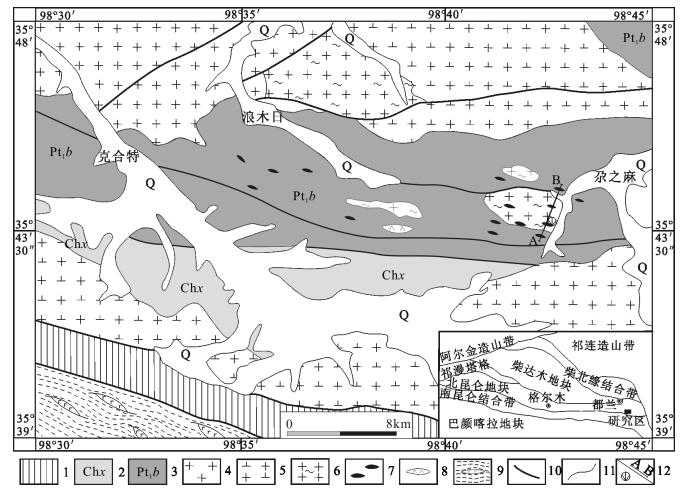
 下载:
下载:

